#225: Radulodon copelandii, The Asian Beauty
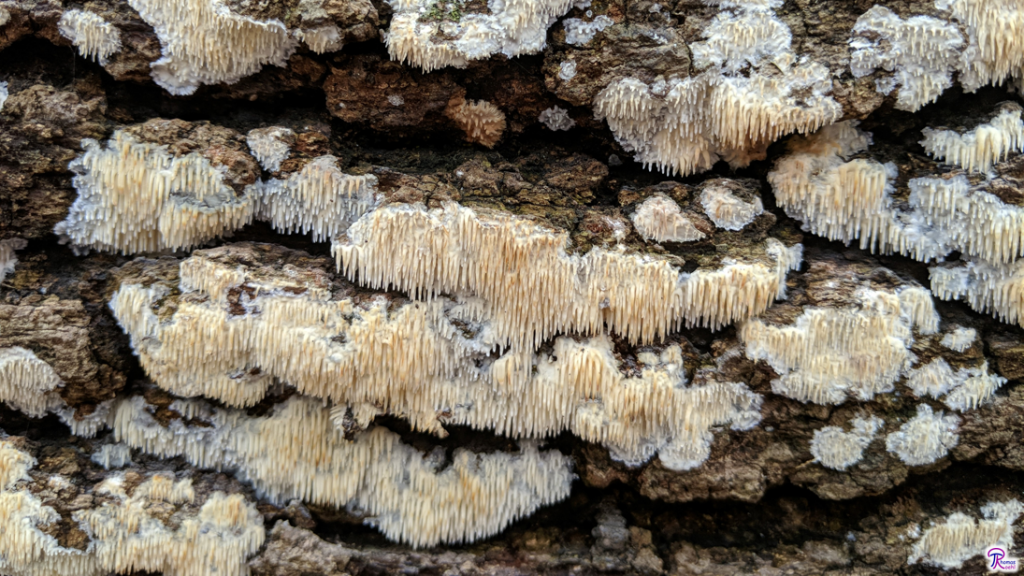
Have you seen Radulodon copelandii? If you live in the Boston, New York, Pittsburg, or Washington DC areas, you probably have. If you live elsewhere on the East Coast of North America, get ready to. R. copelandii is a distinctive fungus that produces a mat of whitish teeth along the surface of recently dead broadleaf trees, usually oaks. The mushroom recently arrived on the continent from Asia, which gives the mushroom its common name, “Asian Beauty.” The Japanese names for the mushroom are “Sagari haritaki” and “hanging needle mushroom.” R. copelandii is currently spreading in eastern North America and is quickly becoming one of the most common mushrooms within its range. This is concerning, so the species warrants further study and monitoring – hopefully by people like you!1–4
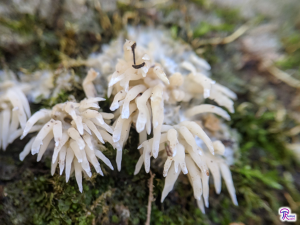
Description
Radulodon copelandii is basically a combination of a crust fungus and a toothed fungus: it is a flat surface that lies against its substrate and sprouts teeth that hang down. The surface begins as a small circular to oval-shaped patch and spreads outward, often fusing with other patches. At its largest it can cover entire logs, although individual patches are usually no longer than 30cm across.1,2
The teeth of R. copelandii are usually flattened, slightly lobed, and up to 1.2cm long.1,2 Teeth often branch a few to several times, although branching is absent or difficult to distinguish in many specimens. They hang down off the surface icicle-like, unless they grow on top of a log, in which case they grow more like a fountain. I find the teeth on top of a log are usually thicker than the ones on the side, probably because they require more support to stand up. When fresh, the teeth grow thick enough that you usually can’t see the flat spreading surface behind them. The teeth are white when young, but they soon become off-white to dull yellowish. However, the tips remain white as long as they continue growing. Once the mushroom stops growing and begins to decay, the tips turn brownish; the orange-brown color spreads up the tooth as that part of the fungus dies back. The teeth get thinner as they dry up, revealing the flat surface beneath them.1,2,5, personal observations
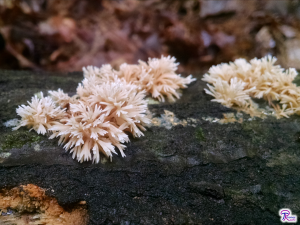
Behind the teeth, the flat surface is the same color as the teeth. When this surface is actively spreading, it has a white ring along the edge and has a slightly fibrous appearance. This area is generally free of teeth, which start developing just at the edge of the white zone. After the mushroom stops spreading along the surface, the edge turns yellowish like the rest of the fungus and teeth begin growing all the way up to the edge.1,2,5, personal observations
R. copelandii doesn’t have many other defining features. It produces no distinctive odor and does not change color when injured.1,2 This lack of features actually helps eliminate some similar species.
Ecology
In my area, R. copelandii is a decomposer of recently dead oak trees and occasionally other hardwoods. This mushroom has also been collected from maples and beeches in the United States and I have seen a picture of it growing on a sycamore.1,2 It causes a white rot on standing dead trees, logs that still have bark on them, and sometimes older deadwood.1–3 One of the distinctive features of R. copelandii in North America is its preference for fruiting in bark furrows.1,2 Asian specimens also grow on dead hardwoods, although in Asia the mushroom can appear on small sticks as well as logs of a variety of broadleaf trees. So far, the mushroom is known to grow in the United States, Canada, Japan, China, Korea, Philippines, Sri Lanka, Malaysia, and eastern parts of Russia.1,3
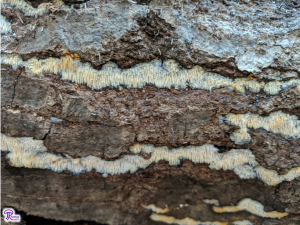
Although R. copelandii seems to prefer cooler temperatures, it fruits at any time of the year. It is most abundant during the fall and winter in North America and during the summer and fall in Japan. However, it is still a common sight at any other time of the year as well.1–3,6
R. copelandii is one of the most common fungi in my area – I always find it on forays – and it might be as common as Stereum ostrea (FFF#144). This is surprising, since it was first spotted in the United States only ten years ago. The first North American report was from November of 2009 in Bradley Palmer State Park in Ipswitch, Massachusetts. Other specimens were found in early 2010 in a few areas 10-20 miles from Boston, Massachusetts.1
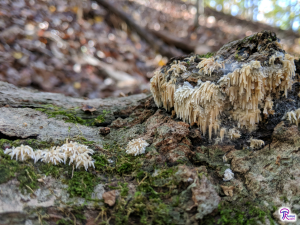
In November 2015, I found R. copelandii fruiting profusely in Scotts Run Nature Preserve just outside of Washington, DC. If the fungus did arrive first in Massachusetts (given how poorly fungi are documented, this is difficult to say for certain), this means it managed to become a dominant species in an area over 400 miles away in only six years. That’s a range increase of about 67 miles every year.
Based on the maps from iNaturalist and Mushroom Observer, the fungus is now present in 11 US states and one Canadian province, from its northern limit just outside Ottawa south to Northern Virginia and from its western limit of far eastern Ohio east to Boston, Massachusetts.4,7 Mushroom Observer also has a record from Missouri,7 although I’m not sure that was identified correctly.
Assuming R. copelandii continued to spread a rate of about 67 miles per year, it should have reached Detroit (Michigan) and the tip of New Brunswick (Canada) and should be approaching Columbus (Ohio), Charleston (West Virginia), Blacksburg (Virginia), and Raleigh (North Carolina). Fortunately, I am not aware of any reports of R. copelandii from those areas. However, that could just be because nobody is looking for it or knows what to call it. Because of the lack of available information, the Washington, DC area mushroom club took three years to find the correct name; other clubs will probably face the same challenges, making it difficult to accurately track the fungus’ spread.
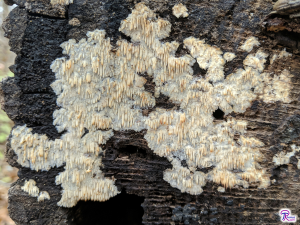
Speaking of spread, I have to wonder what factors are contributing to the mushroom’s amazing rate of range expansion. I tend to find more R. copelandii mushrooms in more urban areas, which could indicate a human role in the fungus’ expansion (of course, I spend most of my time in urban areas, so that may just be a result of selection bias). I’ve also seen a number of different insects crawling around on R. copelandii – perhaps one of those is helping to spread the fungus. R. copelandii has also been noted for producing spores in astounding numbers.1 Once, a colleague of mine watched R. copelandii give off clouds of spores as if it were smoking. Its ability to produce so many spores is likely a major factor in helping the fungus spread.
Given its prevalence and Asian origin, R. copelandii is likely an invasive species. For something to be considered invasive it must meet two criteria: 1) it is not native to a region and 2) it causes harm. R. copelandii is definitely not native to North America. However, nobody has ascertained whether the species is causing harm somehow. Since it is now one of the most common mushrooms within its North American range, it seems likely that R. copelandii is outcompeting native species. This could drive some native species to extinction and disrupt the relationships between wood decomposing fungi and insects, birds, other animals, and other fungi.1 Since nobody has tied R. copelandii to a specific harm, the fungus is not considered an invasive species (at least, not yet).
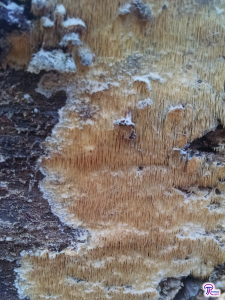
I’ve tried to be thorough, but I hope you can see how much we don’t know about this fungus. How did it get to the United States? When did it arrive? Where is it now? What factors contribute to its spread? How is it interacting with the North American ecosystem? None of those questions will be easy to answer, but at least R. copelandii would be an easy organism to study: you can find it any time of year, it is exceptionally common within its range, and it is fairly easy to identify.
You can help study this fungus simply by taking pictures! If you find R. copelandii, take a photo and upload it to iNaturalist or Mushroom Observer. The more records there are, the easier it will be to track the spread of R. copelandii.
Similar Species
Crusts that have teeth are not very common, but there are a few species that could make identification confusing.
The most similar species is probably Sarcodontia setosa, which I have never seen. This mushroom grows on branches and logs of fruit trees and sometimes other broadleaves. Like R. copelandii, S. setosa grows flat against its substrate and produces dangling teeth. S. setosa can be distinguished by its yellow to bright yellow flesh that bruises redish when injured and its fruity to very unpleasant odor. Additionally, S. setosa seems to be only one color: except where bruised, the teeth are the same color throughout their length.8 To differentiate S. setosa from R. copelandii, do the “Scratch & Sniff Test”: scratch the mushroom to see if it bruises and smell the mushroom to see if it has a distinctive odor.
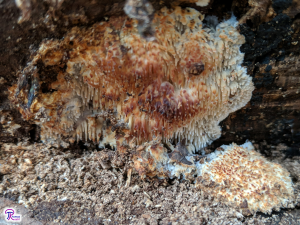
Basidioradulum radula is another similar species: it produces a flat surface with teeth that are white at the tips and yellowish white closer to the base. Unlike R. copelandii, however, its teeth are patchy so you can often see the flat surface underneath. It also seems to have a much tougher texture so its flat surface tends to crack when it dries out.9
Irpex lacteus has a similar color to R. copelandii but is easy to differentiate. I. lacteus produces a surface of irregular white teeth on broadleaf sticks. It is actually a polypore and if you find a fresh mushroom the “teeth” will be tiny pores at the very edges of the mushroom. When mature, the teeth have the consistency of stiff paper, making them much tougher than those of R. copelandii. I. lacteus usually features a downturned top edge, creating a tiny pileus (R. copelandii never does this).10 The species Pseudochaete olivacea is very similar to I. lacteus except that P. olivacea is brownish throughout development and usually does not produce a tiny pileus.11
Steccherinum ochraceum is probably the most regular toothed crust fungus. It has small circular teeth that are evenly spaced along its flat surface. Like I. lacteus, its upper edge is usually downturned to make a small pileus. The upper surface and spreading edge of S. ochraceum are whitish, which contrasts sharply with the orangish teeth and tooth-producing surface.12
Hericium species (such as H. erinaceus, FFF#114) are definitely not crusts, but they produce whitish teeth that hang down from dead broadleaf wood and may appear similar when young. Hericium species grow out from a single point and have a central branched structure that can support the mushroom’s weight. This allows Hericium to grow several centimeters up and out from its substrate. Hericium species either produce much longer teeth than R. copelandii or form an intricately branched mushroom that is more coral-like than crust-like. Finally, Hericium does not produce a flat spreading surface and therefore cannot be called a crust.13
Spongipellis pachyodon is another white toothed mushroom that grows on living or dead broadleaf trees, but it always creates a distinct pileus, making it very easy to differentiate from R. copelandii.14
Trichaptum biforme sometimes produces crust-like growth on broadleaf wood (especially on the bases of recently dead but still standing oaks), although you usually find it producing distinct caps. When it grows in a more crust-like fashion, it produces very short teeth (or pores, since it is actually a polypore) and usually has a purple hue. Even when crust-like, there will be some tiny caps that stick out from the flat surface.15 These features are enough to confidently separate it from R. copelandii.
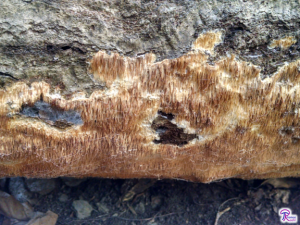
Edibility
Eating invasive species is a great idea to help control them, but it won’t work for R. copelandii. That species is considered inedible and has no known uses.2,3,6
Taxonomy
R. copelandii (which was formerly Radulomyces copelandii and Mycoacia copelandii before that) belongs to the family Meruliaceae, which contains other crust fungi.3,16 Many of these species, such as Phlebia tremellosa, have a wrinkly spore surface and a pileus, making them a little more differentiated than most crust fungi.17 These fungi are all situated in the order Polyporales, so some of their closest relatives are polypores.16,17
Radulodon is derived from the words “radula” – a tiny tooth that mollusks use to scrape food off of surfaces9 – and “-odon” – which refers to teeth.
| Kingdom | Fungi |
| Subkingdom | Dikarya |
| Division (Phylum) | Basidiomycota |
| Subdivision (Subphylum) | Agaricomycotina |
| Class | Agaricomycetes |
| Order | Polyporales |
| Family | Meruliaceae |
| Genus | Radulodon |
| Species | Radulodon copelandii (Pat.) N. Maek.16 |
Citations
- Ginns, J. & Millman, L. Mysterious Asian Beauty Conquers Eastern Massachusetts. Fungi 4, 61–63 (2011). Available at: http://www.fungimag.com/summer-2011-articles/FungiSUM_AsianBeautyLR.pdf.
- Emberger, G. Radulomyces copelandii. Fungi Growing on Wood. Available at: https://www.messiah.edu/Oakes/fungi_on_wood/teeth%20and%20spine/species%20pages/Radulomyces%20copelandii.htm. (Accessed: 21st February 2019)
- Katou. Sagari Haritake サガリハリタケ. Mikawa no shokubutsu kansatsu 三河の植物観察 [Flora of Mikawa]. Available at: http://mikawanoyasou.org/kinoko/sagariharitake.htm. (Accessed: 21st February 2019)
- Radulodon copelandii. iNaturalist.org. Available at: https://www.inaturalist.org/taxa/447856-Radulodon-copelandii. (Accessed: 23rd February 2019)
- Smith, D. Radulodon (Radulomyces) copelandii (4 Photos and Description). Pioneer Valley Mycological Association. Available at: http://www.fungikingdom.net/fungi-photos/basidiomycota/polyporales-order/meruliaceae-family/radulodon-radulomyces-copel.html. (Accessed: 21st February 2019)
- Sagari haritake (shimo Ri hari take) サガリハリタケ(下り針茸) [Sagari haritake (hanging needle mushroom)]. Shizen kansatsu zakki-cho 自然観察雑記帳 [Naturalism Notebook]. Available at: http://naturalism-2003.com/kansatsu/fungi/sagariharitake/sagariharitake.html. (Accessed: 21st February 2019)
- Occurrence Map for Radulomyces copelandii (Pat.) Hjortstam & Spooner. Mushroom Observer. Available at: https://mushroomobserver.org/name/map/39955. (Accessed: 23rd February 2019)
- Emberger, G. Sarcodontia setosa. Fungi Growing on Wood. Available at: https://www.messiah.edu/Oakes/fungi_on_wood/teeth%20and%20spine/species%20pages/Sarcodontia%20setosa.htm. (Accessed: 23rd February 2019)
- O’Reilly, P. Basidioradulum radula (Fr.) Nobles – Toothed Crust. First Nature. Available at: https://www.first-nature.com/fungi/basidioradulum-radula.php. (Accessed: 21st February 2019)
- Kuo, Michael. Irpex lacteus. MushroomExpert.Com (2007). Available at: https://www.mushroomexpert.com/irpex_lacteus.html. (Accessed: 23rd February 2019)
- Emberger, G. Pseudochaete olivacea. Fungi Growing on Wood. Available at: https://www.messiah.edu/Oakes/fungi_on_wood/teeth%20and%20spine/species%20pages/Pseudochaete%20olivacea.htm. (Accessed: 23rd February 2019)
- Kuo, Michael. Steccherinum ochraceum. MushroomExpert.Com (2010). Available at: https://www.mushroomexpert.com/steccherinum_ochraceum.html. (Accessed: 23rd February 2019)
- Kuo, M. The Genus Hericium. MushroomExpert.Com (2004). Available at: https://www.mushroomexpert.com/hericium.html. (Accessed: 23rd February 2019)
- Emberger, G. Spongipellis pachyodon. Fungi Growing on Wood. Available at: https://www.messiah.edu/Oakes/fungi_on_wood/poroid%20fungi/species%20pages/Spongipellis%20pachyodon.htm. (Accessed: 23rd February 2019)
- Kuo, M. Trichaptum biforme. MushroomExpert.Com (2004). Available at: https://www.mushroomexpert.com/trichaptum_biforme.html. (Accessed: 23rd February 2019)
- Radulodon copelandii. Mycobank. Available at: http://www.mycobank.org/BioloMICS.aspx?TableKey=14682616000000067&Rec=81445&Fields=All. (Accessed: 21st February 2019)
- Kuo, M. Phlebia tremellosa. MushroomExpert.Com (2008). Available at: https://www.mushroomexpert.com/phlebia_tremellosa.html. (Accessed: 23rd February 2019)

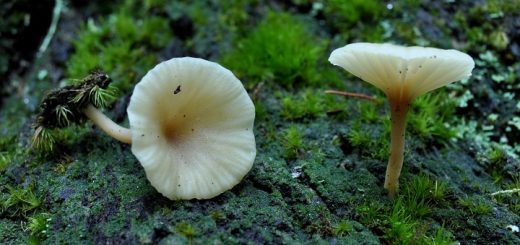






![#011: Characteristics of Kingdom Fungi [Archived]](https://www.fungusfactfriday.com/wp-content/themes/hueman/assets/front/img/thumb-small-empty.png)
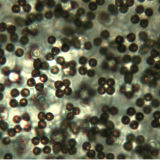
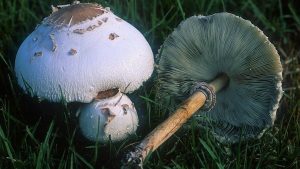
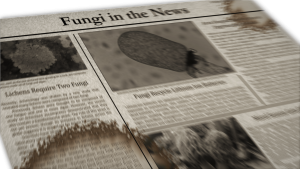
I think I found this! I’ve been trying to ID for years so was delighted to read about what it (likely) was.
It looks like I’ve found a patch of this fungus in Mount Jefferson State Natural Area in North Carolina. Hope it’s not too harmful.
Thanks for noticing it! Could you take photos of it and upload them to either iNaturalist or Mushroom Observer? This will be a great help in tracking the spread of the fungus — there are currently only two records of R. copelandii in North Carolina, but I’m sure it’s more common.
Thanks for this! I found it fruiting this November in Seneca Tract Park, Loudoun County, VA. It didn’t look like Sarcodontia, but nothing else in the field guides was even close. Glad to have an ID.
There is a kind of newly described sps. of Radulomyces, found in Long Island in 2016 and published on 2018, named R. paumanokensis, by Karen Nakasone. It is orangy, grows on top of mossy trees and is forked. https://www.researchgate.net/publication/327187093_Radulomyces_paumanokensis_J_Horman_B_Ortiz_K_Nakasone_sp_nov_Fungal_Biodiversity_Profiles_51-60_Cryptogamie_Mycologie_2018_39_2_1-47
“Figure 11. Radulomyces paumanokensis – a newly reported
species in eastern North America. The type species was
collected from a rotted hardwood log on Long Island, New
York. The specific epithet paumanokensis is derived from
Paumanok, the Native American name for Long Island, the type
locality. The specimen above was growing in New Jersey.
It is included on this page as a potential look-alike for
R. copelandii. Unlike R. copelandii, R. paumanokensis
fruitbodies are not as effused. They are described as compact,
hemispherical to ovoid in shape (up to 50 x 50 mm). In
addition, the spines (up to 20 mm long) are more highly
branched. Fresh fruitbodies are white to orange-white to
pale orange, drying to pale orange, grayish-orange or
orange-gray. Photo © Maricel Patino
Figure 12. Another specimen of Radulomyces paumanokensis
from NJ. Photo © Maricel Patino.”
This page © 2008 by Gary Emberger, Messiah University”
^^ documented in the area well before then.
https://www.messiah.edu/Oakes/fungi_on_wood/teeth%20and%20spine/species%20pages/Radulomyces%20copelandii.htm
documented in Long Island and NJ in 2008 at this link:
https://www.messiah.edu/Oakes/fungi_on_wood/teeth%20and%20spine/species%20pages/Radulomyces%20copelandii.htm